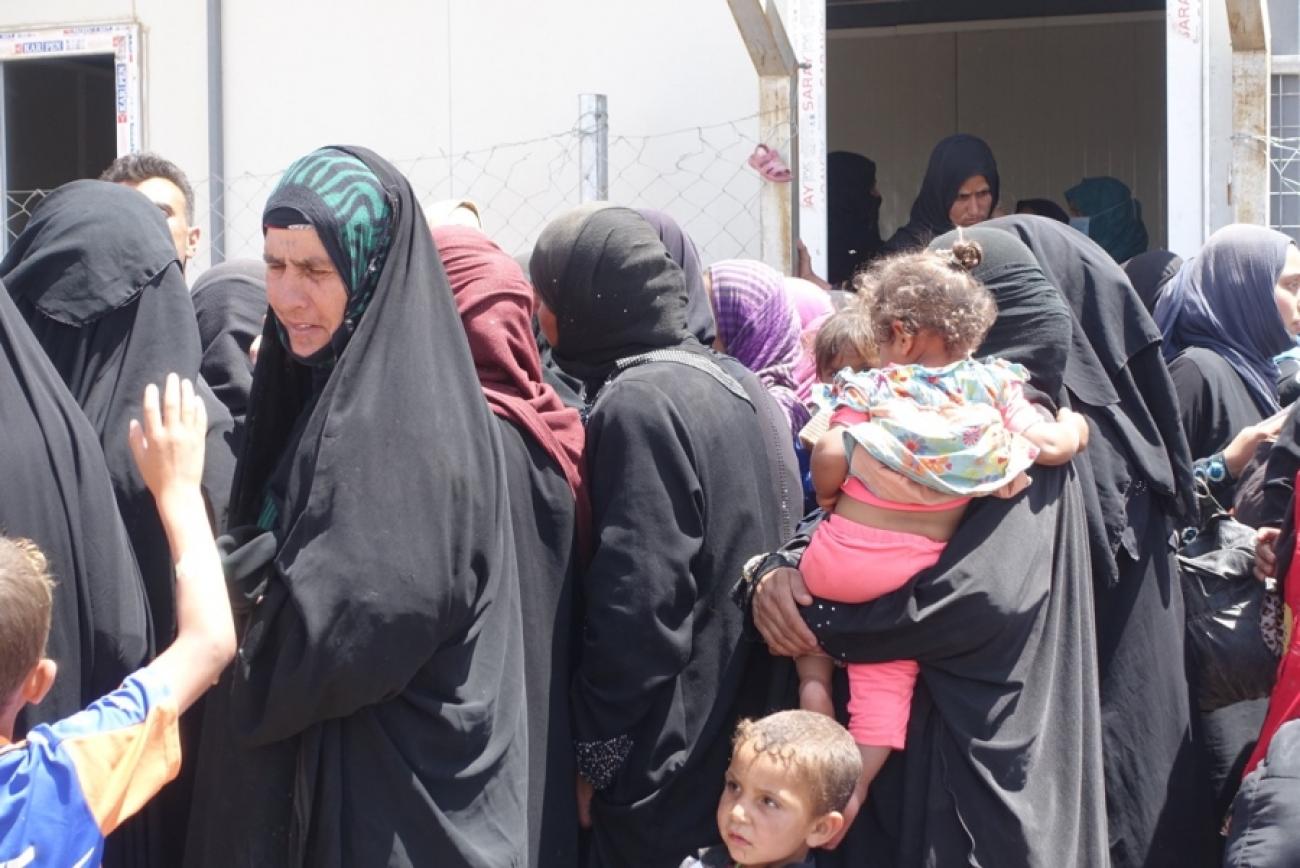Thousands Continue to Flee West Mosul: UN Migration Agency

An average of 10,000 individuals are fleeing from West Mosul and arriving daily at the transit Zone in Hamam al-Alil
Iraq - An average of 10,000 individuals are fleeing from West Mosul and arriving daily at the transit Zone in Hamam al-Alil, according to the military and camp management there.
Last Thursday (May 18) the number of people fleeing West Mosul peaked when some 16,100 individuals passed through the Hamam al-Alil screening site, according to government figures. It was the largest official daily movement of people since the Mosul operation began on October 17, 2016.
With gruelling high temperatures during the day most opt to make the trip in the cooler hours of the night, leaving and walking several hours before reaching the nearest military checkpoints.
From there, the men, women and large number of children are transported to the town of Hamam al-Alil town south of Mosul, on the western banks of the Euphrates, in Ninewa governorate.
The town, the largest south of Mosul city has become the transit hub for the tens of thousands of families who have fled the conflict in West Mosul.
With the camp adjacent to the site at full capacity, many families are being moved to other camps, with large numbers opting to go to areas east of Mosul where they stay with families, friends or in rental accommodation.
According to Iraq Government figures, cumulatively, more than 742,000 people have been displaced from Mosul and its surrounding areas since October 16, 2016, when the military offensive began, including 566,000 individuals displaced from western Mosul since the second phase of the military offensive to retake the city was launched in mid-February. More than 73,000 Iraqis were displaced last week alone.
An estimated 117,732 individuals have returned to their areas of origin in east Mosul, while 34,841 people returned to West Mosul.
The current number of IDPs from western Mosul who remain displaced is more than 531,000 individuals.
An estimated 200,000 individuals are still entrapped under ISIL territories in Mosul’s Old City. As of May 23, IOM’s Displacement Tracking Matrix (DTM) has tracked and located more than 377,000 individuals (nearly 63,000 families) currently being sheltered in camps and emergency sites. This includes people living in host communities, informal sites and rented homes.
In Hamam al-Alil on Wednesday (24/05), families arriving from newly retaken areas spoke of ISIL horrors, extreme shortages of food, medicines, water and power as well as the fear of being shot while escaping.
“We ran out of food and were left with ground wheat and the skins of the wheat we had stocked earlier,” Um Omar, said.
She said that towards the end, their meals consisted of boiled hay.
Another woman surrounded by her tired and restless children said she knew of families who were now cutting grass and wild plants they can find for food.
Nearly 85,000 children are still trapped as a result of the offensive to retake Mosul, and water supplies in the camps for the displaced are “stretched to the limits,” according to UNICEF.
But despite the hardships, the long walk to safety, the fear and hunger, for the many who arrive at Hamam al-Alil, it is as if they have been reborn again.
The new mantra or popular catch phrase amongst Iraqi IDPs who succeed in escaping ISIL has become “Thank God, we are reborn again.”
Not all, however, are as lucky.
In IOM’s field hospital, in partnership with Qatar’s Red Crescent, in Hamam al-Alil, young Abdul Rahman sobbed his heart out as he recounted the day his house came under ISIL mortar attack killing his elder brother and severely injuring his leg.
“I am afraid…” the skeletal 11-year old sobbed quietly from his bed at the field hospital.
“I lost my leg…” he cried. “I wont be able to run or play football anymore.”
“My brother was sitting next to me, then the house came down on us and he was killed,” Abdul Rahman recounted, as he lay in bed with his right leg, amputated to a stump, just above the knee.
Unable to leave the house due to the hail of mortars being fired by ISIL on their neighbourhood that day, Abdul’s brother Ahmad (22) and a father of an 8-month-old baby, bled for four hours from his injuries before he eventually died.
Abdul’s father eventually managed to carry his injured young son Abdul Rahman and move him to another location. It took five days and five different locations before the young boy was eventually brought to IOM and Qatar’s Red Crescent field hospital where he could receive treatment.
By the time he arrived at IOM’s field hospital, despite the desperate efforts by surgeons to save his leg, the limb tissues to his severed arteries were dead and young Abdul Rahman’s leg had to be amputated.
As the Iraqi military forces close in on the Old City and the last remaining neighbourhoods, reports from the injured and escapees suggest that ISIL is tightening, what remains of its grip against the civilians.
“They are calling out from the mosque minarets, warning that they will shoot the children if families attempt to escape,” Um Ahmad said.
“They are even booby trapping our front doors to prevent us from escaping,” said Hassan who lay in one of IOM’s hospital beds recovering from injuries to his legs.
Unbeknown to him, ISIL had laid explosives at the entrance of his house. As stepped out to escape the explosives went off.
In another bed Saadoun stood vigilant moving from one bed to another checking on his two young boys: Qaws, a 3-year-old injured in the leg and Yassin 7, who was injured in the head.
Back in the Hamam al-Alil camp, where the family of seven members are crammed with relatives in a tent, he left three other children who are also injured.
A bomb aimed at their neighbour’s house, which ISIL was occupying with the family as human shields, brought down his own house over their heads.
His five children were all injured, and his neighbours killed including a grandmother and two children.
“I couldn’t dig out my neighbours from under the rubble,” Saadoun lamented sadly.
Some 12,500 people have been transferred from frontline areas to hospitals for trauma injuries treatment as of 20 May according to OCHA; including 6,369 people from West Mosul alone.
IOM Iraq Chief of Mission Thomas Lothar Weiss said: "The fact that huge numbers of Iraqis continue to flee West Mosul, despite the dangers involved, is a testament of both the dire situation inside, and the enormous task ahead of us to alleviate the suffering of IDPs. IOM and our humanitarian partners in cooperation with the Government of Iraq, will continue to provide comprehensive humanitarian assistance and lifesaving support to IDPs to the full extent of our resources.”
IOM’s DTM actively monitors displacement across Iraq. The latest DTM Emergency Tracking figures on displacement across Iraq and due to Mosul operations are available at: http://iraqdtm.iom.int.
Click to download the latest DTM documents:
DTM Mosul Operations Factsheet – 25 May
http://iraqdtm.iom.int/downloads/DTM%20Emergency%20Tracking/Mosul%20Cris...
For further information, please contact IOM Iraq:
Hala Jaber, Tel: +964 751 740 1654, Email: hjaberbent@iom.int or
Sandra Black, Tel: +964 751 234 2550, Email: sblack@iom.int
Written by


